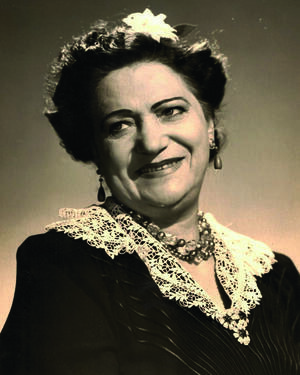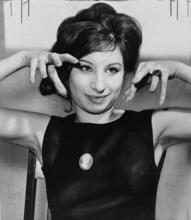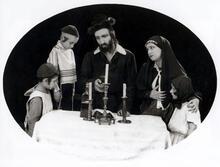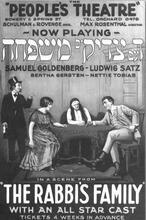Anna Appel
Anna Appel was known for her performance of motherly characters in Yiddish and English roles on stage and screen. When Appel joined a Yiddish vaudeville company in 1904, her family sat shiva for her. She played several different roles before her big break in 1918, when she joined the cast of Morris Schwartz’s popular Yiddish Art Theater. She was a cast member for the next ten years and was praised for her performances. In the 1920s and 1930s, she began playing parts in Yiddish films, including Yizkor, Broken Hearts, and The Symphony of Six Million in 1932. In 1928, she played her first English-language role as the star of Poppa, starting a successful Broadway career. Her final Broadway appearance was in 1959’s The Golem.
Article
Anna (Khane) Appel, a highly acclaimed character actor, straddled the Yiddish- and English-language worlds of theater, film, and television. Excelling in both comic and dramatic roles, she was especially acclaimed for the versatility of her mimic art. A tall woman with an expressive round face, Appel became noted for her mother roles.
On May 1, 1888, Anna was born in Bucharest, Romania, where her parents, Bernard and Jeanette (Schaeffer) Bercovici, owned a hotel. Anna went to primary and secondary schools and studied Yiddish privately until the family’s immigration to Montreal, Canada, in 1902. Drawn to acting since early childhood, she joined a Yiddish amateur dramatic club in Montreal. After moving to New York in 1904, she became a member of a Yiddish vaudeville company. According to Appel, her family was so furious that they sat shiva for her. In 1906, she married Yiddish vaudeville actor Isadore Appel, with whom she had a daughter, Helen. Their marriage ended with his death in 1909. In 1915, she married Dr. Sigmund Ben-Avi and was widowed a second time in 1924. Her son, Avrum Ben-Avi, born in 1916, became a faculty member at the New York University Graduate School of Psychology. Appel’s third partner was Morris Ross.
After her first husband’s death, Appel continued to play in Yiddish vaudeville until 1916, when she joined Jacob P. Adler’s company for one season. Her success began in 1918, when she, along with Celia Adler, Berta Gersten, Jacob Ben-Ami, and others, formed the original company of Morris Schwartz’s Yiddish Art Theater in New York. A regular cast member until 1928, she continued to perform with the company off and on until its demise in 1950. Among her noteworthy performances were in Sholem Aleichem’s Dos Groyse Gevins [The Big Win], Hirschbein’s A Farvorfn Vinkl [The Secluded Nook], Shaw’s Mrs. Warren’s Profession, and Gorky’s The Lower Depths.
During the 1920s and 1930s, Appel appeared in the Yiddish films Yizker [Memorial Prayer] (1924) and Broken Hearts (1926), both featuring the actors of the Yiddish Art Theater. Later followed Grine Felder [Green Fields] (1937), Yankl der Shmid [The Singing Blacksmith] (1938), and Amerikaner Shadkhen [American Matchmaker] (1940). In Hollywood, she appeared in Faithless (1933) and was featured in The Heart of New York and The Symphony of Six Million, both 1932 melodramas set on Manhattan’s Lower East Side.
At age forty, Appel debuted on the English-language stage with a starring role in Poppa (1928). During her ensuing thirty-year career in English, she performed in Did I Say No? (1931) and Awake and Sing (1936), as well as in such Broadway productions as Good Neighbor (1941), All You Need Is One Good Break (1950), the revival of Abie’s Irish Rose (1954), in which she enjoyed outstanding success, Highway Robbery (1955), Comic Strip (1958), and The Golem (1959), which marked her final Broadway appearance. Anna Appel’s last public appearance was on television in 1961. She died in New York on November 19, 1963.
Praising Appel for her performance in Good Neighbor, critic Brooks Atkinson wrote: “She probably could act the telephone book, if necessary, for she has great strength as an actress and great warmth as a person.
American Jewish Biography (1994).
“Apel, Khane.” Leksikon fun Yidishn Teater [Lexicon of the Yiddish theater]. Vol. 1, edited by Zalmen Zylbercwaig (1931).
Appel, Anna. Archival materials. Billy Rose Theatre Collection, New York Public Library, Lincoln Center, NYC, and Yiddish Theatre and Photo Collection, YIVO Institute for Jewish Research, NYC.
Ehrenreich, Chaim. “Khane Apel: Ire Groyse Mayles: A Vort af Ir Frishn Keyver” [Anna Appel: her great qualities: A word at her fresh grave]. Forverts (November 29, 1963): 8.
Hoberman, J. Bridge of Light: Yiddish Film Between Two Worlds (1991).
“Khane Apel: Balibte Yidishe Shoyshpilerin, Tot Tsu 75 Yor” [Anna Appel: Popular Jewish actress, dead at 75]. Forverts (November 21, 1963): 1.
Mukdoyni, A. Teater (1927).
Notable Names in American Theatre (1976), s.v. “Necrology”.
Obituary. NYTimes, November 21, 1963, 39.
Who’s Who in Hollywood, 1900–1976 (1976), s.v. “Late Players”.
WWIAJ (1938).






